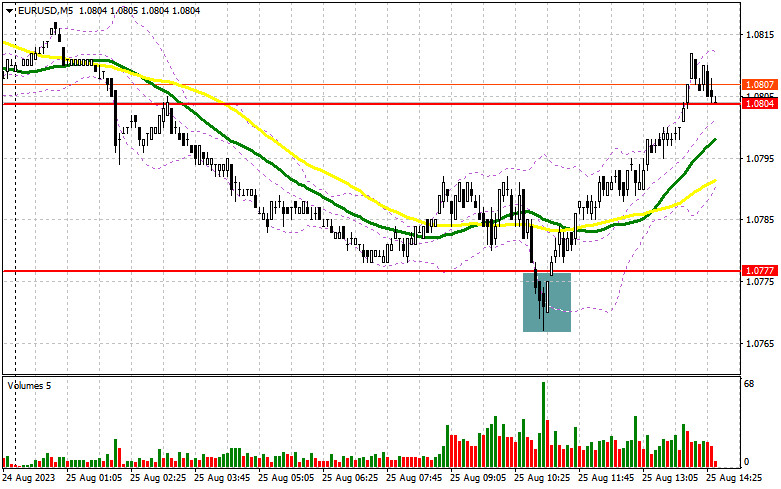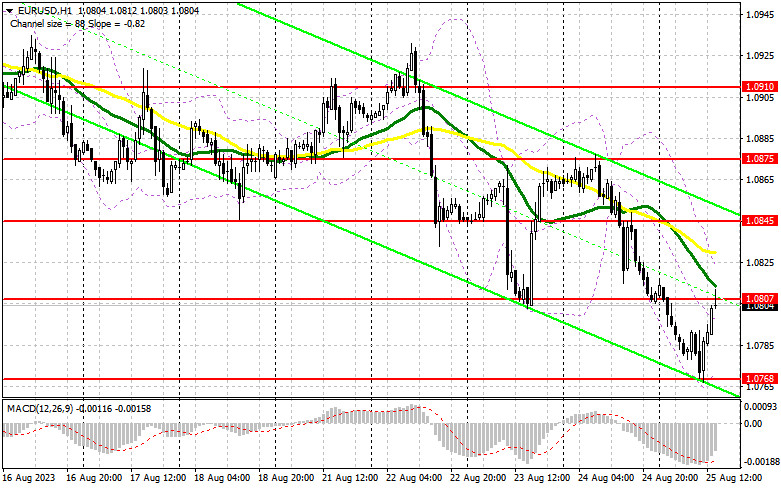
In my morning forecast, I drew attention to the 1.0777 level and recommended making market entry decisions based on it. Let's look at the 5-minute chart and figure out what happened there. A decrease and the formation of a false breakout led to an excellent entry point for buying the euro, resulting in an upward movement of almost 30 points. Considering what's ahead, the technical picture has been revised only slightly for the afternoon.

For opening long positions on EUR/USD:
As I mentioned this morning, the upcoming speech by Fed Chairman Jerome Powell is of note. A tough stance on combating inflation and direct hints at another rate hike, perhaps even two, will lead to a new decline of the euro to monthly lows and possibly even breaking them. A softer "wait-and-see" stance might help the euro cope with seller pressure. If EUR/USD drops, I will only act on a false breakout around the 1.0768 support level formed today. This will signal the opening of long positions with a recovery prospect to the nearest resistance of 1.0807, which was recently tested. A breakout and a top-down test of this range against the backdrop of Powell's soft rhetoric will restore demand for the euro, offering a chance for an upward spike and a renewal to 1.08454. The ultimate target remains at 1.0875, where I will be locking in profits. If the EUR/USD drops and there's no activity at 1.0768 in the afternoon, the pair's decline will continue with renewed vigor. In such a case, only the formation of a false breakout around the next support at 1.0734 – a new monthly low – will signal to buy the euro. I will immediately open long positions on a rebound from 1.0705, targeting an upward correction of 30-35 points within the day.
For opening short positions on EUR/USD:
Sellers need to push harder ahead of the important statements by the Fed Chairman. Yes, a false breakout was formed at 1.0807, and the pair might even drop back to the monthly lows of 1.0768, but a larger movement can only be expected after Jerome Powell's speech. For this reason, if there isn't a quick downward movement from 1.0807, it's better to exit short positions. Only after a breakout and securing below 1.0768, followed by a bottom-up retest, will there be a signal to sell, allowing EUR/USD to continue its bearish trend with a renewal of the monthly low of around 1.0734. The ultimate target will be the 1.0705 area, where I will lock in profits. If the EUR/USD moves upward during the American session and there's a lack of bears at 1.0807, although the situation won't entirely revert to buyer control, the chances of an increase will grow. With such a development, I'll postpone short positions until the next resistance at 1.0845. I can sell there, but only after a failed consolidation and after Powell's speech. I will immediately open short positions on a rebound from the high of 1.0875, targeting a downward correction of 30-35 points.

The COT (Commitment of Traders) report dated August 15 showed an increase in long positions and a decrease in short positions. These indicators already consider important US inflation data, which, as we can see, brought some buyers back to the market. Minutes from the Federal Reserve, released last week, also showed that not all committee members are ready to raise interest rates to combat inflation. This maintains the chances for a euro recovery, especially after the Jackson Hole symposium, where Federal Reserve Chairman Jerome Powell will speak later this week. His speech may shed light on the future policy of the central bank. The recent euro drop seems to be an attractive moment, as, despite this, the optimal medium-term strategy in the current conditions remains to buy risk assets on declines. The COT report indicated that non-commercial long positions increased by 4,418 to 232,466, while non-commercial short positions decreased by 5,634 to 72,603. As a result, the spread between long and short positions jumped by 1,125. The closing price decreased to 1.0922 from 1.0981 a week earlier.
Indicator signals:
Moving Averages:
Trading occurs around the 30 and 50-day moving averages, indicating a sideways market trend.
Note: The author considers the period and prices of the moving averages on the hourly H1 chart and differs from the general definition of classic daily moving averages on the D1 daily chart.
Bollinger Bands:
In case of an increase, the upper boundary of the indicator around 1.0825 will act as resistance.
Indicator descriptions:
• Moving average (determines the current trend by smoothing volatility and noise). Period 50. Marked in yellow on the chart.
• Moving average (determines the current trend by smoothing volatility and noise). Period 30. Marked in green on the chart.
• MACD indicator (Moving Average Convergence/Divergence — convergence/divergence of moving averages). Fast EMA period 12. Slow EMA period 26. SMA period 9.
• Bollinger Bands. Period 20.
• Non-commercial traders are speculators, such as individual traders, hedge funds, and large institutions, who use the futures market for speculative purposes and meet certain requirements.
• Non-commercial long positions represent the total long open position of non-commercial traders.
• Non-commercial short positions represent the total short open position of non-commercial traders.
• The total non-commercial net position is the difference between non-commercial traders' short and long positions.